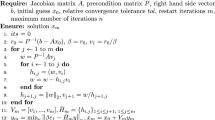Abstract
Complex physical phenomena can be usually split into several interacting physical computational models and can be numerically simulated by coupling parallel codes individually designed for these models. Besides rational splitting and efficient numerical methods for different models, we must design scalable parallel algorithms to concatenate these parallel codes. Meanwhile, three objectives should be well balanced. The first is how to efficiently transfer data among multiple physical models, the second is how to inherit original scalability of parallel codes and then ensure good scalability of full simulation, and the third is how to ensure independent or simultaneous developments of codes by different research groups. This paper presents two concatenation algorithms for parallel numerical simulation of radiation hydrodynamics coupled with neutron transport on unstructured grid. The first, Full Loose Concatenation Algorithm, focuses on independent development and inheritance of original scalability, and the second, Two Level Compact Concatenation Algorithm, focuses on optimal tradeoff among above three objectives. Theoretical analysis for communicational complexity and parallel numerical experiments using hundreds of processors on two parallel machines have shown that these two algorithms are efficient and can be generalized to other parallel numerical simulations for hydrodynamics coupled with radiation or neutron transport. In particular, the second algorithm is linearly scalable and has achieved theoretical optimal performance.
Similar content being viewed by others
References
L. Deyuan X. Guorong (1987) Numerical Methods for Two-Dimensional Non-Steady Hydrodynamics Chinese Academic Publisher Beijing
R. L. Bowers and J. R. Wilson, Numerical Modeling in Applied Physics and Astrophysics, Jones and Bartlett publishers (1991).
E. E. Lewis W. F. Miller (1984) Computational Methods of Neutron Transport Wiley New York
K. Schloegel G. Karypis V. Kumar (2003) High-Performance Scientific Simulations J. Dongara I. Foster G. Fox W. Gropp K. Kennedy L. Torczon A. White (Eds) Sourcebook of Parallel Computing Morgan Kaufmann Publishers San Francisco, CA
S. Plimpton B. Hendrickson J. Stewaert (1998) A Parallel Rendezvous Algorithm for Interpolation Between Multiple Grids, in Proc. of Supercomputing’98 IEEE Computer Society Press Los Alamos, CA
G. Karypis V. Kumar (1998) Multilevel Algorithms for Multi-Constraint Graph Partitioning, in Proc. of Supercomputing’98 IEEE Computer Society Press Los Alamos, CA
K. Schloegel G. Karypis V. Kumar (1999) A New Algorithm for Multi-Objective Graph Partitioning, in Proc. of Euro-Par’99 Springer Berlin 322–331
G. Krypis, Multi-Constraint Graph Partitioning for Contact/Impact Computations, in Proc. of Supercomputing’03, Phoenix, AZ (November l5–21, 2003).
G. Zhi and L. Hongguan, Numerical Methods and Programming for Radiation Hydrodynamics, Technical Report, Institute of Applied Physical and Computational Mathematics, IAPCM-2003–087 (1998).
F. Lianxiang and Y. Shuling, Numerical Methods and Programming for Neutron Transport, Technical Report, Institute of Applied Physics and Computational Mathematics, IAPCM-1999–023 (1999).
T. A. Wareing, J. M. McGhee, J. E. Morel, and S. D. Pautz, Discontinuous Finite Methods Sn Methods on 3-D unstructured Grids, in Proc. of International Conference on Mathematics and Computation, Reactor Physics and Environment Analysis in Nuclear Applications Madrid, Spain (1999)
W. Gropp, E. Lush, and R. Thakur, Using MPI-2: Advanced Features of the Message-Passing Interface, Scientific and Engineering Computation Series, MPI Press (1999).
M. Zeyao F. Lianxiang (2004) ArticleTitleParallel flux sweep algorithm for Neutron Transport on Unstructured Grid J. Supercomput. 30 IssueID1 5–17 Occurrence Handle10.1023/B:SUPE.0000032778.36178.d8
M. Zeyao F. Lianxiang Y. Shulin (2004) ArticleTitleParallel Pipelined Sn Algorithm for Neutron Transport on Unstructured Grid Chinese J. Comput. 27 IssueID5 587–595
B. Hendrickson and R. Leland, The Chaco User’s Guide: Version 2.0, Technical Report, SAND94 -2692, Sandia National Laboratories, Albuquerque, NM (1994).
M. Zeyao Z. Baolin (2001) ArticleTitleMultilevel Averaging Weight Method for Dynamic Load Imbalance Problems Int. J. Computer Math. 76 463–477
Author information
Authors and Affiliations
Corresponding author
Rights and permissions
About this article
Cite this article
Zeyao, M. Concatenation Algorithms for Parallel Numerical Simulation of Radiation Hydrodynamics coupled with Neutron Transport. Int J Parallel Prog 33, 57–71 (2005). https://doi.org/10.1007/s10766-004-1461-1
Received:
Revised:
Accepted:
Issue Date:
DOI: https://doi.org/10.1007/s10766-004-1461-1




